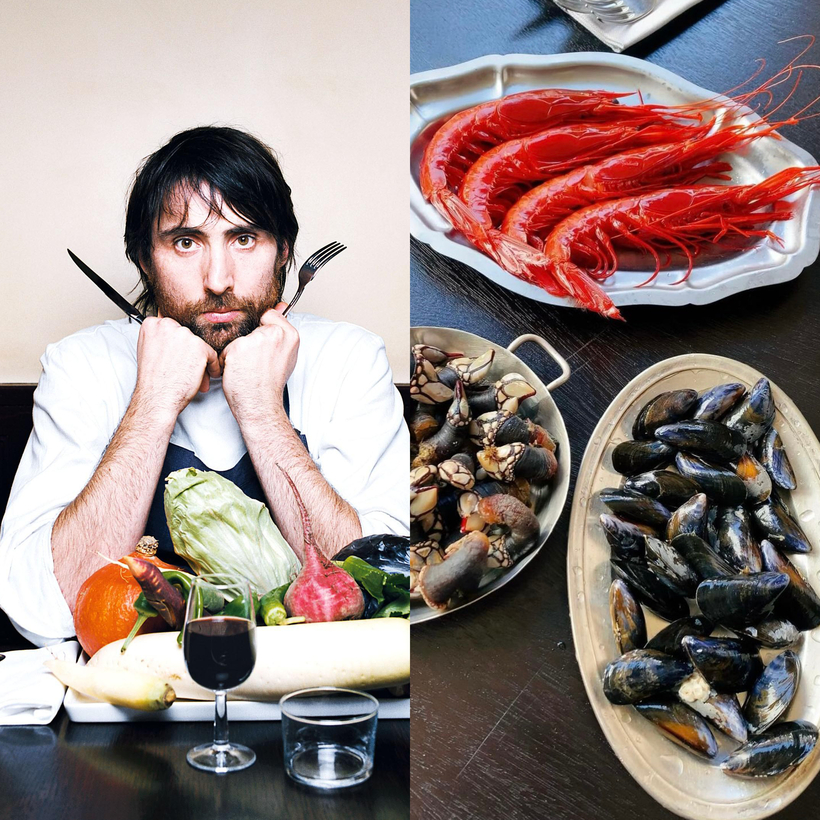Those who have followed the Paris restaurant scene at any point since the early 2000s have probably been to, or at least heard of, Le Chateaubriand, in the hip 11th Arrondissement, and its neighboring wine bar, Le Dauphin.

There, the iconoclastic chef Iñaki Aizpitarte has challenged and delighted diners, critics, and international-awards judges with his singular, stripped-down cuisine. It’s hard to find an article on him that doesn’t nod to his contribution to the bistronomy movement—bistro fare combined with gastronomic techniques—or use the term “rock star” to describe his status and preternatural cool.
It’s equally difficult to deny his influence on a generation of chefs, or the evolution of the 11th Arrondissement into a food destination. But if you’re hoping to spot Aizpitarte smoking out front after service, you’ve got a five-hour journey ahead of you.

There were years of rumors that he and his partner, ex–Chez Aline chef Delphine Zampetti, were moving back to the Côte Basque, on France’s western shore and close to the Spanish border, where he grew up, with their teenage son. They prompted as many “final” visits from regulars and gastro-tourists as from those who flock to Le Baratin, where the owners, who are friends and mentors of Aizpitarte, have long been threatening to retire.
He still keeps an eye on Le Chateaubriand, now in the capable hands of a chef de cuisine. But in February, Aizpitarte opened Petit Grill Basque in Saint-Jean-de-Luz. Zampetti took over the adjoining space for her sandwicherie, Chez Maya. Plenty of chefs have left cities for small towns since 2020, but none this generationally impactful or for towns this small. Imagine David Chang moving home to Vienna, Virginia (population 16,276), to take over a 1920s pub.

Granted, Saint-Jean-de-Luz is a tidily bourgeois, immensely charming beach town near Biarritz, with plenty of Parisian homeowners and more than 10 restaurants in the Michelin guide. (Many of them still serve the squiggly-sauce food that Aizpitarte made his name with in the early 2000s at the Montmartre restaurant La Famille.)
As with the 1930s bistro that became Le Chateaubriand, Aizpitarte cleaned up the local institution Petit Grill Basque and added a few touches. He refreshed the stenciled motifs by the 1920s painter Louis Floutier and added plaid Basque fabric to the shades. (Think of Le Veau d’Or, in New York, where the new owners spent almost five years making the 1930s institution look … the same.)
Plenty of chefs have left cities for small towns since 2020, but none this generationally impactful or for towns this small.
Next door, Zampetti did an equally photographable job of refreshing the old traiteur. She serves tortilla española with guindilla peppers on warm baguette alongside hearty plats du jour such as her trademark chicken, cooked pot-au-feu-style.
From Tuesday to Saturday, Aizpitarte is in the kitchen with his young team, serving a $40 prix fixe lunch and an à la carte dinner. You can hear the hum of contented conversation as you turn onto the side street. The restaurant’s 10 tables might be filled with discreetly flush older locals opening their third bottle of natural wine with dessert, a young surfer couple who made the trip from Toulouse, and a slightly out-of-place gastronaut down from Paris to see what the chef is up to on his home turf. (Guilty!)
After less than a year, the restaurant has the warmth and casual confidence of a local institution (albeit one led by a chef who once ranked ninth on the World’s 50 Best list and whose wine bar was designed by Rem Koolhaas).

At Le Chateaubriand, Aizpitarte’s food could be brutal: stark and challenging. But what makes his punk posturing so transfixing is that it almost always works.
At Petit Grill Basque, he’s either toned it down for the neighbors or simply matured. Always an instinctual and intellectual chef, Aizpitarte, now in his late 40s, seems to have tapped into some emotion, too. There’s even a steak frites on the menu, with the fries cooked twice in beef fat.
My meal began with a Chateaubriand-level challenge—chunks of line-caught tuna confited in heritage-pork fat. It was followed by a comfort dish of hand-cut steak tartare with pickled peppers. Two large carabinero shrimp, a delicacy at $21 apiece, were dressed with piment-spiked oil and sweet fried garlic.
Spurred by a vibrant bottle of Pays Basque white wine, I ordered almost all of the desserts, including an ethereal île flottante dotted with salted caramel and strawberries macerated in blackberry vinegar with whipped cream.
Between services, Aizpitarte can be seen chatting with guests and staff at the old bar, or outside on his phone, relaxed and at home in his trademark blue T-shirt and apron. Until the 90s in France, middle-aged star chefs moved to the country and opened a Relais & Châteaux auberge, baroquely decorated by their second wife. Today’s stars start a restaurant group, get product deals, and go on France’s Top Chef.
Depending on your lens, Aizpitarte’s retreat can be seen as a mike drop or stepping into the open tomb left by his Basque predecessor. Either way, as Michelin would—and will—say, it’s worth the trip.
Christine Muhlke, a former editor at The New York Times and Bon Appétit, is a co-author of Wine Simple, with Le Bernardin’s Aldo Sohm, and a co-author of Phaidon’s Signature Dishes That Matter. She is also the founder of culinary consultancy Bureau X and the creator of the Xtine newsletter


